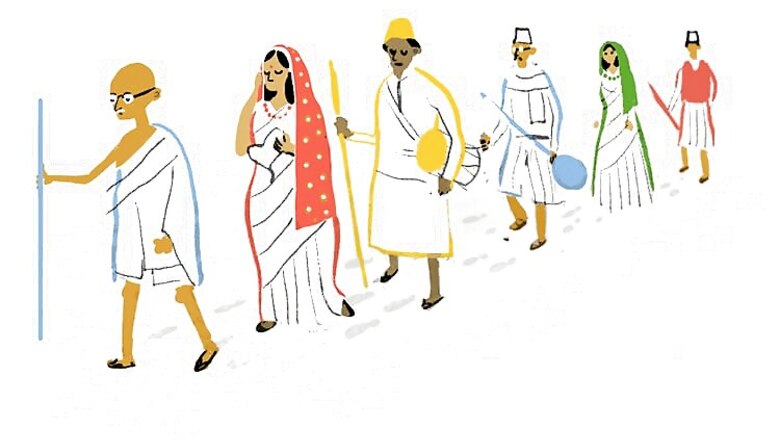
views
New Delhi: Mahatma Gandhi leads protesters in breaking the British government's unfair salt laws on the Google India home page celebrating the 69th Independence Day of the country.
"Today, we celebrate the people who laboured tirelessly for Indian identity, leading to the ratification of the Indian Independence Act 1947," says Google.
The India's Independence Day doodle has been drawn by doodler Leon Hong and depicts the Salt March of 1930 (also known as Dandi March or Salt Satyagraha). Mahatma Gandhi led the march from Sabarmati Ashram, near Ahmedabad, to the coastal village of Dandi. The march began on March 12, 1930 and Gandhi broke the salt laws by making salt (without paying the tax that the law that that time demanded) on April 6, 1930.
"Mahatma Gandhi led the 240-mile (386 km) march to Dandi, inspiring millions of Indians to commit acts of civil disobedience and changing the way the world perceived the movement for Indian independence. The message of the historic 24-day march echoed around the world for years to come and significantly influenced activists like Martin Luther King Jr and James Bevel in the US," says Google describing the doodle.
With the doodle, Google also salutes the Indian movement for Independence at the heart of which "were nonviolence and civil disobedience, a desire to protect the rights of minorities, and a cultural renaissance driven by voices of poets and writers."
The six people shown on the doodle stand of each letter of the Google logo and are outlined in the corresponding colour. This is the second time Mahatama Gandhi has featured on a Google doodle. The first was on October 2, 2009 on his 140th birth anniversary and was displayed on Google home page across the world.

The 2015 India's Independence Day Google doodle is reminiscent of the Dandi March sculpture (commonly referred to as '11 Murti' (11 statues) by Devi Prasad Roy Choudhury on New Delhi's Sardar Patel Marg.
Google is also taking its users on a virtual tour of India's first Independence Day in 1947 via the Google Cultural Institute.
Twitter on its part has added support for then Indian flag emoji to allow Indians worldwide celebrate the day.
Facebook has greeted its users in India with a personalised message on the country's Independence Day and prompted users in India to add "celebrating Indian Independence" to their status updates.
Google has been commemorating India's Independence Day on its India home page since 2003.
The 2003 doodle was quite similar to the one that Google posted a couple of years later in 2005 and only had the Tricolour fluttering on the letter 'L' of the Google logo that seemed to double up as a flag post.

There was no Independence Day doodle on Google's India home page in 2004.
The 2005 Indian Independence Day Google doodle had the second 'O' in the Google logo replaced by the Ashoka Chakra.

The Google 2006 Indian Independence Day doodle was also with a flag theme, in which the second 'O' of the Google logo was symbolised by the Ashoka Chakra.

2007 was the 60th year of Indian Independence and Google highlighted the fact with the text "Celebrating 60 years of Independence" on its doodle where the Indian flag appeared behind the Google logo.

There was no Google India Independence Day doodle in 2009. In the 2008 doodle, the Indian flag fluttered over the letters 'L' and 'E' in the Google logo.

The 2010 Google India's Independence Day doodle was perhaps the most creative of all the ones that Google created to celebrate India attaining freedom. It was the first and only animated India Independence Day doodle and was done in traditional rangoli style. The second 'O' in the Google logo was in the form of a lotus in the Indian flag's colours that started to take shape as the page was loaded.

Most of the Google doodles had the Indian national flag as the inspiration. But the 2011 and 2012 doodles used other national symbols in place of the Tricolour. In 2011 a sketch of Delhi's Red Fort took guard on the Google home page on 15th August.

India's national bird, the peacock, adorned the Google home page on India's Independence Day in 2012. The peacock curved its neck backwards to form the 'G' of the Google logo. The other letters of the Google logo appeared in ornate styling behind the peacock's plume.

A Tricoloured ribbon spelt out the Google letters on the Google India home page in 2013.

In 2014 doodle on the Google India home page on August 15 was a familiar symbol - independent India's first stamp.

The first stamp issued by free India was months after Independence on November 21, 1947 and it depicted the Indian national flag with the popular slogan - "Jai Hind (Long Live India)" written in Hindi. The stamp was valued at three and one-half annas.


















Comments
0 comment